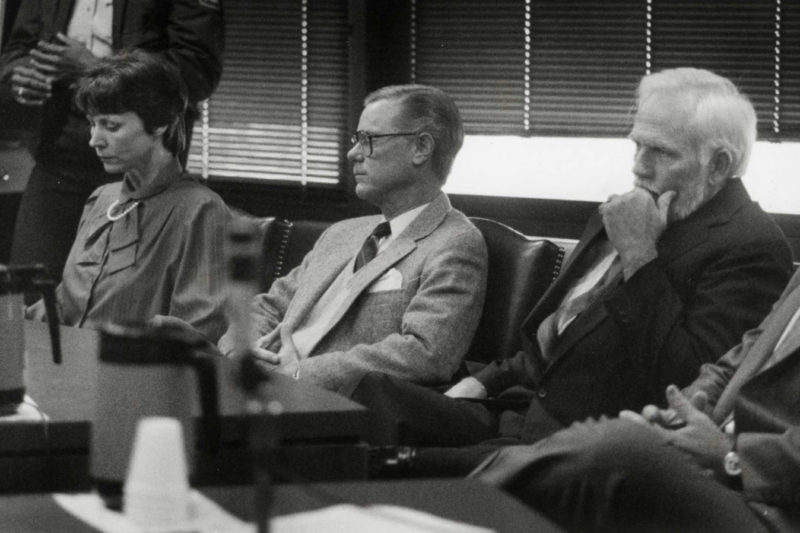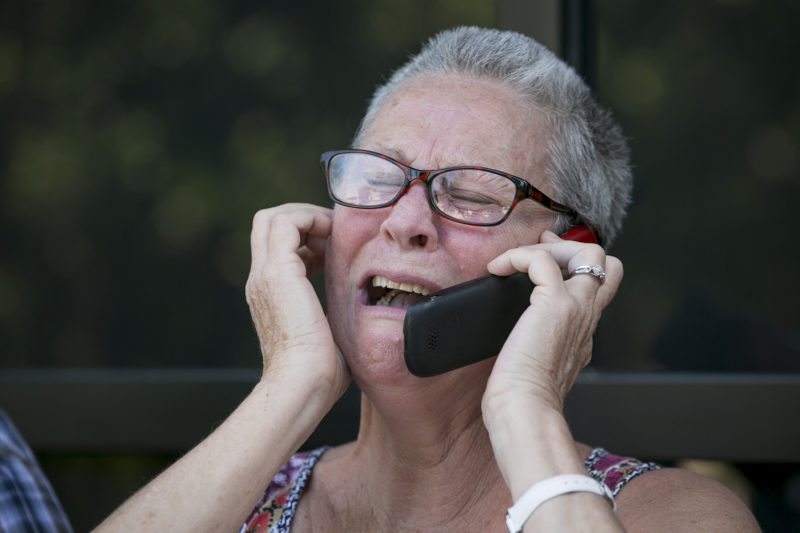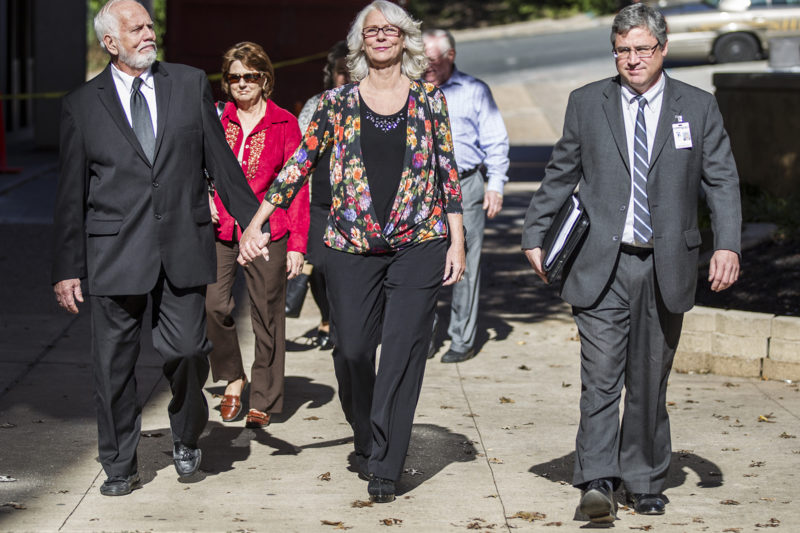Before QAnon, Satanic Panic Gripped Central Texas
By Ramón Rodriguez
Reporting Texas

Fran and Dan Keller leave the courtroom following testimony in their trial on Nov. 19, 1992. The Kellers were wrongfully sent to prison for sexually abusing children in satanic rituals at their South Austin daycare. They were exonerated and released in 2013. (File photo by Larry Kolvoord/Austin American-Statesman)
Thirty years ago, Oak Hill daycare owners Dan and Fran Keller were convicted and sentenced to 48 years in jail — a likely death sentence for Dan, 50 at the time, and Fran, then 42. Their supposed crime: sexually abusing children during satanic rituals. The Kellers were accused of forcing children to drink blood-laced Kool-Aid and to watch Dan and Fran dismember people with a chainsaw.
Today, the children’s claims are believed to have been false memories planted by the suggestive questioning of parents, law enforcement and therapists. But the damage was done. The Kellers made an ill-planned flight to Las Vegas following their indictment. Ineffective lawyering, the suppression of exculpatory evidence and an overzealous prosecution ultimately banished the couple to the bottom of the prison totem pole.
The Fran and Dan Day Care Center is just one case in the 1980s and ‘90s frenzy known as Satanic Panic. Alleged satanic ritual abusers were convicted in Texas, North Carolina, California and Arkansas. Anxiety about a changing society made it easy for people to believe such outlandish claims, experts say.
Theories about satanic conspiracies have erupted periodically through American history starting with the Salem Witch Trials in the 1690s. A new satanic witch hunt — the far-right conspiracy theory QAnon — has gained steam in the last few years. Once again, fear and anxiety over a rapidly changing world have expressed themselves in what looks like a delusion.
It was Aug.15, 1991, when a 3-year-old girl first brought forth the allegations about the Kellers and their day care. Soon other children came forward with allegations of their own. It was heartbreaking for the couple. “We raised them from babies,” Fran said.
The claims sparked a massive investigation and national media frenzy. In November 1992, the trial began — with many certain of the Kellers’ guilt, though some were firmly convinced of their innocence.
The case rested on a single, damning piece of evidence: fresh tears in the 3-year-old’s hymen and her testimony that Dan had raped her. The girl’s parents were going through a tumultuous divorce, and the girl had been severely acting out at school and home.
At the trial, the girl would continue to act out and would claim both to have not even known the Kellers nor to have even testified about sex abuse at all. Randy Noblitt, a psychologist investigating satanic ritual abuse for the state, would claim that the Kellers were using secret hand signals to influence their victims to stop their testimony, explaining the girl’s unreliability on the stand.

From left to right, Fran Keller, defense attorney Lewis Jones, and Dan Keller in court on November 17, 1992. (File photo by Rebecca McEntee/Austin American-Statesman)
Mostly though, the prosecution chose to play down the Satanic angle, and it was instead the court-appointed defense attorneys who introduced the idea of satanic ritual abuse, believing that the jury would believe the claims too outlandish to be true. Instead, the Kellers became part of a dark statistic — daycare abuse cases at that time boasted an 85 percent conviction rate.
The Kellers were split into separate prisons. They were spit on, food was taken away from them and they were threatened by other inmates on a daily basis. Fran was raped at least twice. Dan, an artist, coped by using coffee and a Q-tip to paint pictures of Willie Nelson and prisoners trying to write home.
The next major moral panic emerged in the late 2010s.
QAnon alleges satanic ritual child abuse. Many in the movement claim a cabal of global elites are harvesting the psychoactive compound adrenochrome from children’s blood. Many adherents believe former president Donald Trump will be the one to deliver the American public from the control of the pedophilic cabal.
It’s a conspiracy theory that has gained purchase in Texas GOP circles — four Texas Republicans voted in 2020 against a resolution in the U.S. House of Representatives resolution to reject QAnon claims. Nationally, 56 percent of Republicans believe the allegations to be at least partly true, according to a Daily Kos/Civiqs poll.
Chris French, who researches paranormal beliefs at the University of London, said reasons for the enduring popularity of these beliefs are complex. He pointed to the increase in outlandish beliefs at times of great uncertainty — a feeling that things are out of control — and at the human need to identify an enemy.
He called QAnon believers “skeptics without the critical thinking” and pointed to the popularity of religion in the United States — as opposed to his native United Kingdom.
“It’s pitching your religion and your faith against this great evil to show that it’s stronger, it’s right, it’s the correct way to see things,” French said.
Travis View, host of the popular podcast QAnon Anonymous, agreed. “It comes from a simplistic worldview and the belief that there are two opposing forces — pure godly good and wretched satanic evil who do the worst things imaginable,” he said. “When you want to think of yourself as a very good person, you want to fight the worst thing you could possibly do.”
Daytime television energized the Satanic Panic, and the internet is what’s energizing QAnon, View said. He traced a timeline to the Salem Witch Trials and Revolutionary France, when the proliferation of pamphlets coupled with expanded literacy rates stirred a revolution.
“Whenever there’s a new revolution in communications and media, that leads to conspiracy theories,” View said. “All of a sudden, common people were able to read about and hear about the bad things that the king was doing. That dispelled the myth that they were these divinely ordained beings.”
Meanwhile, QAnon has not been weakened at all by Trump’s Twitter ban, View said. He pointed to the election of vocal QAnon supporter and Georgian Marjorie Taylor Greene to the U.S. House of Representatives and the believers’ migration to the non-mainstream social media platforms Gab and Telegram.
“As a consequence of simmering in the dark corners of the internet, they will become even more wrapped up in their fictional world and even more radicalized,” he said.

Fran Keller cries while receiving the news from her attorney, Keith Hampton, on Tuesday August 22, 2017, that tomorrow she will receive her money from the state fund for those wrongly convicted of crimes. (File photo by Jay Janner/Austin American-Statesman)
Austin attorney Keith Hampton worked for no charge to help exonerate the Kellers. They were released from prison in late 2013.
In 2017, they were declared innocent and received a $3.4 million compensation for their prison time. Prior to their payment, the couple struggled financially and had difficulty adapting to a world that moved on without them.
“The prosecutors weren’t ill-meaning — they were true believers. They really thought there were sacrifices going on. They were swept up in that,” Hampton said
Fran is hesitant to talk to the media. She says it was “shocking” for her and Dan to go from private citizens one day to having to endure cameras in their face and intrusive questioning.
The Kellers originally resisted talking to Reporting Texas, but Fran finally agreed. Dan, who is now 80, is described as more at peace with the past by both Hampton and Fran, with Hampton likening him to “a Buddhist monk.”
“We have dreams about prison and what’s happened to us,” Fran said. Still, she says she forgives everybody. “That’s all you can do. Give it over to God.”
These days, the couple has retreated from public view and now live on an eight acre ranch in New Braunfels, rarely speaking about their experience, though Hampton wishes the couple would be more open to sharing their experience with the world. He thinks it could go a long way toward securing justice for the other wrongfully convicted.
Although Fran is unfamiliar with QAnon, she acknowledges that the hysteria that took her and Dan as victims is a cycle that comes around every twenty years or so.
“We’re happy and we’re happy to be back in the world. Hope it doesn’t happen to others. But they’ll have a lot of support if they do,” Fran said.

Dan and Fran Keller make their way into the Travis County courthouse with their attorney Keith S. Hampton. They succeeded in proving their innocence in the daycare sexual assault case from the early 1990s that put them in prison. (File photo by Ricardo B. Brazziell/Austin American-Statesman)